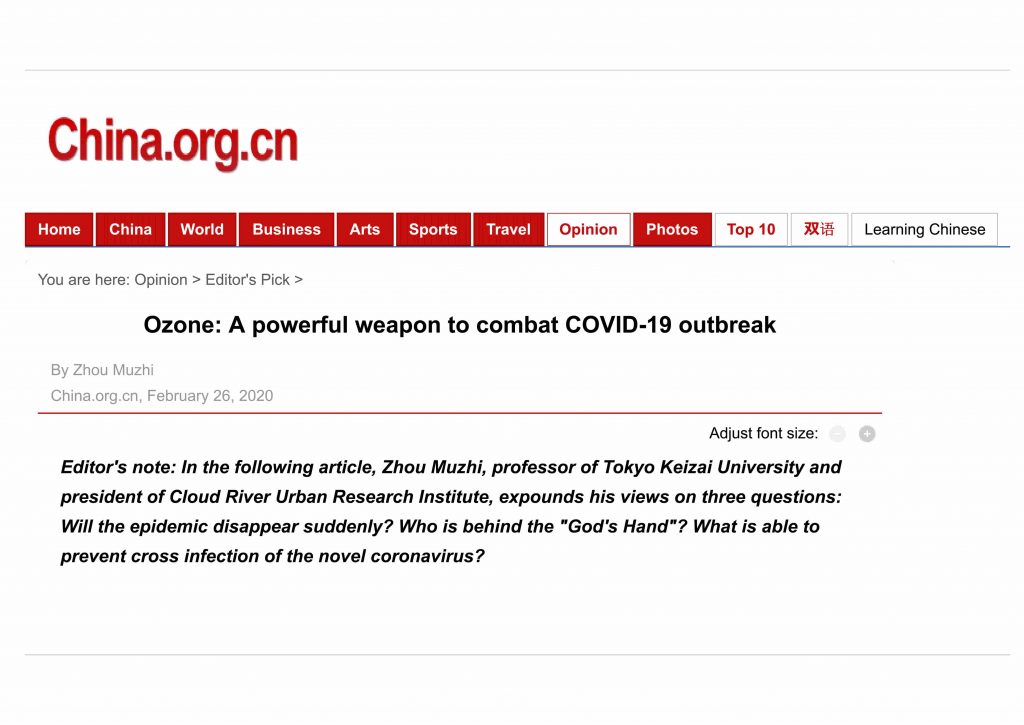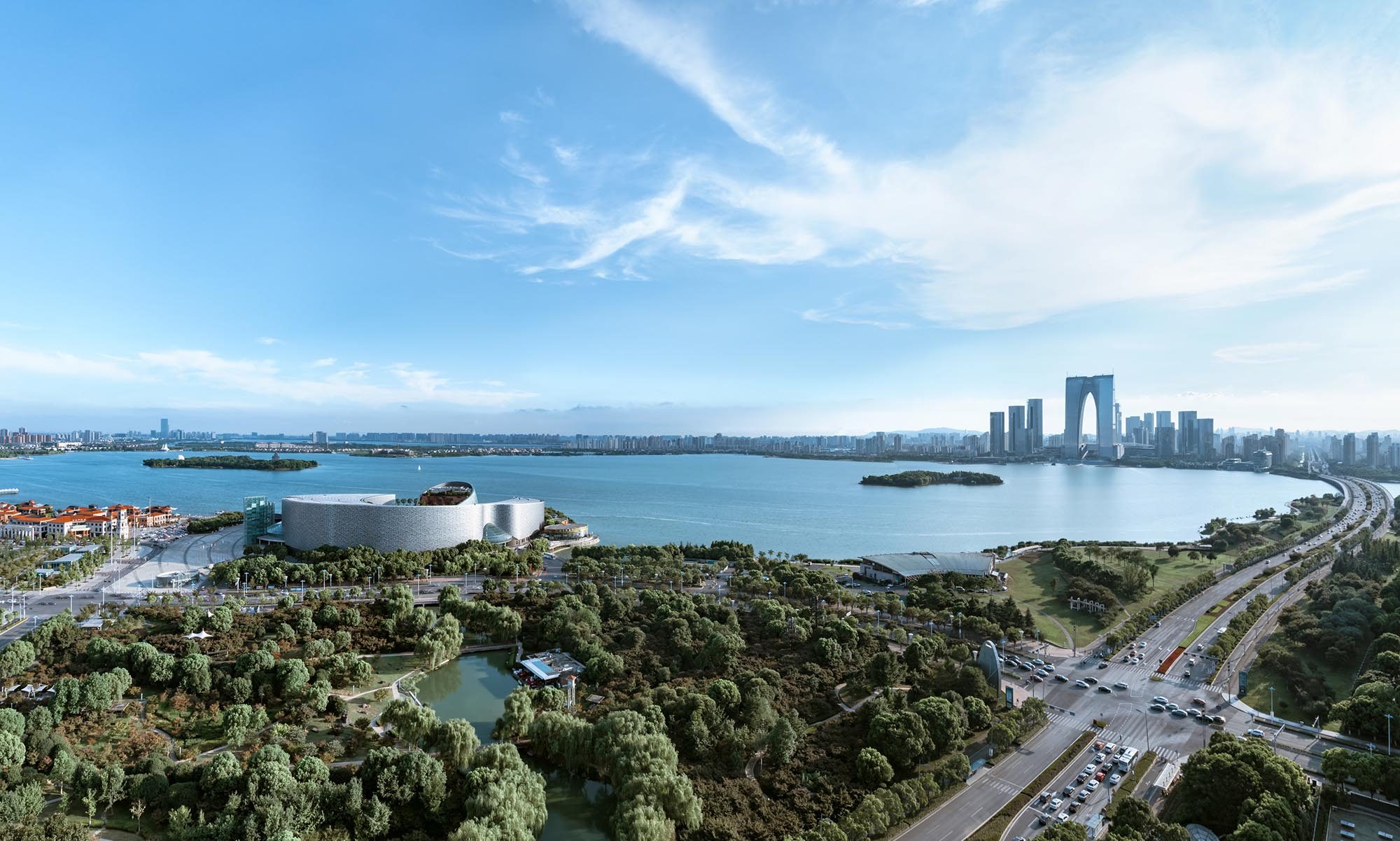
Editor’s note: In the following article, Zhou Muzhi, professor of Tokyo Keizai University and president of Cloud River Urban Research Institute, expounds his views on three questions: Will the epidemic disappear suddenly? Who is behind the “God’s Hand”? What is able to prevent cross infection of the novel coronavirus?

1. The earth’s protective shield
Since the recent outbreak of the novel coronavirus disease (COVID-19), I have been discussing with Zhang Yue, president of BROAD Group, on how to use ozone for sanitation purpose. Zhang is among one of the first advocates for ozone’s application, but has failed to draw much attention. I also notice people’s caution against or even ignorance of the ozone use from my discussion with atmospheric scientists as well as based on related research studies. Therefore, it is necessary to take a closer look at the ozone gas in order to reduce misunderstanding and even possibly promote ozone use in combating the current coronavirus outbreak.
The troposphere is the lowest layer of our atmosphere, which starts from ground level all the way extending upward to about 10 kilometers. The temperature generally decreases with the altitude. The next layer up is called the stratosphere, which extends from the top of the troposphere to about 50 kilometers above the ground, with the temperature increasening all the way up. The “infamous” ozone layer is found within the stratosphere, with a concentration of 10 to 20 ppm (parts per million). By absorbing the high-energy ultraviolet (UV) light from the Sun, the ozone layer acts as a shield for some UV damage to the cellular DNA, thus protecting the life on earth.
The time when the ozone layer reaches the current concentration almost coincides with the time when life on earth evolves from the ocean to the land. In other words, the higher level in ozone concentration may play an important role in the colonization of life on land, as a thin ozone layer could only allow for life to exist in the ocean. To put it simply, life or organisms, which formerly only existed in the ocean to shield from the harmful UV radiation, were able to migrate on shore thanks to a higher level of ozone concentration.
It is fair to say that no life can be found on the earth without the protection of the ozone layer.
The use of man-made chemicals in industrial development such as chlorofluorocarbons (CFCs) and other volatile organic compounds (VOC) is now causing extensive ozone dissociation that could weaken the human’s immune system and increase the risk of skin cancer and cataract. Thus, more attention has been given to the ozone depletion, as some even see it as a major global environmental concern no less than global warming and call for stronger protection for its proper functioning.
Ozone is a gas made up of three oxygen atoms (O3). It is created primarily by ultraviolet radiation. When high-energy ultraviolet rays strike ordinary oxygen molecules (O2), they split the molecule into two single oxygen atoms, known as atomic oxygen. A freed oxygen atom then combines with another oxygen molecule to form a molecule of ozone. As an allotrope of oxygen, the pale blue gas has a distinctively pungent smell. The word ozone comes from the Greek word OZEIN, meaning “to smell.”
High levels of ozone concentration can filter harmless UV radiation, thus acting as a shield to protect the life on the earth.
2. Angel in the sky, devil on the ground?
Ozone not only exists in the stratosphere but is also present at ground level. As oxygen molecules decrease and oxygen atoms increase with higher altitude, the high concentration of the ozone layer is found in the stratosphere while its lower concentration rests at the ground or higher above the atmosphere. That is to say, its concentration peaks at around 10 kilometers above the ground level and then drops in even higher altitude.
In the troposphere near the earth’s surface, the natural concentration of ozone is about 0.02 to 0.06 ppm, which is harmless to the human being. As the concentration level grows, it can cause discomforts to human body and may even be harmful to eyes and the respiratory system. The FDA’s maximum allowed ozone concentration in the air for residential areas is 0.05 ppm ozone by volume; the Japan Society for Occupational Health (JSOH) recommends the Occupational Exposure Limits (OELs) for ozone concentration is 0.1 ppm; while the China National Health Commission has set the safe ozone threshold as 0.1 ppm.
What really made ozone “notoriously famous” is the photochemical smog, which refers to a mixture of pollutants, including primary pollutants like nitrogen oxides (NOx) and volatile organic compounds (VOC), together with secondary pollutants ozone produced in the chemical reaction of UV ray. Although NOx and VOC are the primary source of photochemical smog, the share of ozone in the smog could reach as high as 90%. So people usually equate photochemical smog pollution with ozone pollution.
Photochemical smog not only stimulates mucosa tissues like eyes and respiratory system, it could also cause sore eyes, headaches, coughing and asthma. It could also inhibit plant growth that leads to crop failure, and even cause more hazards like acid rain and visibility reduction.
Since the industrial revolution, mass emission of NOx has led to an increase of ozone in the troposphere by 300% in the past 100 years. The rapid industrialization and urbanization in East Asia, led by China, has seen growing photochemical smog pollutants like Nox, which also accelerated increase of ozone concentration in the troposphere.
Although the concentration in the troposphere is merely a tenth of that in stratosphere, ozone is still the third largest contributor to global warming among all greenhouse gases, following carbon dioxide and methane.
All the factors above has led to a common belief that ozone is a harmful pollutant in the troposphere, and some even compare it “angel in the sky, devil on the ground.” Several developed countries including Japan has made the observation and prevention of ozone cross-border pollution in the troposphere an important research topic.
However, it should be justified that the ozone in photochemical smog is at an unnaturally high concentration due to man-made pollution, much higher than the normal concentration of ozone in the troposphere. Moreover, unlike pure ozone in nature, photochemical smog consists of a large amount of hazardous pollutants like NOx and VOC. Concentration of ozone in nature varies by season and geography, but generally does not reach levels that can harm the human health. For example, one way ozone is naturally produced is through electrical excitation of oxygen molecules in lightening. Due to ozone’s purification effect, the air is usually more refreshing after thunder and lightning. Another example would be the refreshing air in the coastlines and forest because of high ozone concentration.
Therefore, naturally produced ozone is anything but hazardous. We must recognize the difference between the naturally produced ozone and ozone in the photochemical smog, and should not blame it as a cause for environmental pollution.
Because of insufficient research and studies at this front, we often fail to recognize ozone as a protective shield in the troposphere.
Though harmless to big living creatures, ozone could pose serious threats to microorganisms. As a strong oxidizing agent, ozone has always been inhibiting microbe reproductions, while also acting as a balancing power to ecological equilibrium. Unfortunately, little attention has been given to its role in sanitation.
One reason is that low concentration of ozone was not believed to have sanitation values. According to a Japanese study, however, low concentration of ozone is still able to kill bacteria, viruses and molds, if given enough exposure. It is fair to say that ozone has balanced and inhibited the overgrowth and reproduction of microbes on earth.
Furthermore, naturally produced ozone can also decompose hazardous organics, stimulate the human’s immune system, etc. Some researches even believe that it plays a vital role in reflecting to seasonal changes and controlling body function cycles. All in all, without ozone in the troposphere, the earth would be in a entirely different state, unfit for humanity to survive.
In fact, ozone is beneficial for human and nature in both troposphere and stratosphere. It is the man-made pollution that “demonized” ozone by breaking the natural balance on earth.
3. ‘Hand of God’ conjecture: Ozone dispels epidemic?
SARS raged from the winter of 2002 to the spring of 2003, causing extreme panic in society. However, it suddenly disappeared around May and June, leaving various speculations behind. Coincidentally, most of the airborne viruses, such as the influenza virus, erupt in the autumn and the winter and disappear in the spring and the summer. It seems that there is an invisible “hand of God” driving away the epidemic and saving people.
Most researchers looked for correlations between viruses and temperature/humidity. Taking influenza virus as an example, it is generally believed that the virus can maintain its activity for a long time under the condition of low temperature and humidity, and that its activity will be inhibited as the temperature and humidity increase. However, experiments have shown that everyday temperature changes actually do not affect the virus much, but increasing humidity can effectively increase its death rate.
A hypothesis gradually emerged from the discussion with Zhang Yue: perhaps ozone with germicidal and disinfectant ability is the real “hand of God”?
The ozone concentration changes significantly with the seasons: low in autumn and winter and high in spring and summer. According to observations of the ozone layer by Japan Meteorological Agency, the total amount of ozone for Sapporo, Tsukuba, Kagoshima and Naha – Japanese localities from north to south, generally reaches a peak in February to May, but the peak in the farther north comes earlier and that in the farther south comes later.
The ozone concentration varies from region to region as well. The above observations also show a higher peak concentration in the northern regions and a lower peak concentration in the southern regions. Studies have observed that the total amount of ozone in the earth’s atmosphere changes significantly with latitude: lowest in equatorial regions and highest in northern regions near latitude 60°.
Theoretically, the stronger the ultraviolet rays, the faster the oxygen molecules disassociate. The equatorial regions, where the sun shines the most, are the most prone to producing ozone. However, many factors and complex mechanisms act on ozone concentration. The stronger the ultraviolet rays, the easier it is to either produce ozone or break it down. The rate of ozone disassociation is also related to temperature: the higher the temperature, the faster the disassociation. Earth-scale atmospheric circulation is also one of the factors that cannot be ignored, because it can transport the ozone generated locally to other regions.
The largest source of tropospheric ozone is the ozone layer in the stratosphere. The oxygen produced by plants through photosynthesis and the NOx and VOC emitted out of industrial activities also affect the concentration of tropospheric ozone.
In short, the ozone concentration, which depends on the magical disassociation and polymerization of oxygen molecules and oxygen atoms, shows a pattern of low in autumn and winter and high in spring and summer. Moreover, the higher the temperature, the faster ozone molecules break down. Humidity also matters, and the germicidal ability of ozone would decrease sharply in the dry state. Therefore, here comes the bold conjecture: when the seasons change and the weather turns warmer, the ozone concentration and air humidity would rise, and the “hand of God” would begin to dispel epidemics.
The more rigorous rationale should be that assisted by temperature and humidity, the main force – ozone drives away epidemics as its concentration rises with the seasons. Of course, ultraviolet rays, another killer of microbes, also kills outdoor bacteria and viruses.
If the conjecture is true and ozone is the “hand of God”, then the epidemic caused by novel coronavirus, like SARS and flu, should vanish as ozone levels rise over the seasons, which can be a prospect offering a ray of hope for those suffering from the outbreak.
Certainly, the bold conjecture requires careful verification, and suggestions from different perspectives are more than welcome.
4. Using ozone to kill novel coronavirus
For more than 100 years, ozone, considered a killer of virus in the nature, has been widely used by people for disinfection, sterilization, deodorization, disintoxication, storage, and bleaching thanks to its strong oxidablity.
And because of this, ozone should be adopted as a weapon in the global fight against COVID-19. It has three following attributes.
Full coverage. Ozone created by ozone generators or electrostatic air purifiers can reach every corner of the environment, which can overcome the problem that ultraviolet sterilization can only go straight up and down, leaving some places unsterilized.
High detergency. Oxidizing bacteria and virus is how ozone works, with no poisonous residue. On the contrary, the chemical disinfectant we use now is not only harmful to human body, but also will cause secondary population of poisonous residue. During the current epidemic, the overuse of disinfecting water has been a serious problem that we should pay attention to.
Convenience.Ozone can be produced by simple equipment. The equipment, large or small, can be used for a single room, a large public space, or public transportation modes such as buses, high-speed railways, ships and airplanes.
The effectiveness of ozone in treating bacteria and virus is not only related to its concentration, temperatures, humidity and exposure time, but also related to the strains of bacteria.
According to results of the experiment on how ozone kills SARS virus conducted by the national P3 laboratory headed by Professor Li Zelin, ozone is effective in killing the SARS virus inoculated on green monkey kidney cells, realizing a killing rate of 99.22%. The virus found in Wuhan and SARS virus both belong to the coronavirus. Researchers found that the novel coronavirus is 80% similar to the SARS virus in their genome sequences. It is reasonable to predict that ozone is equally effective in preventing and controlling the new coronavirus.
Ozone, though highly effective for sterilization and disinfection, will cause discomfort, or irritate mucous membranes, when it reaches a certain concentration level. Therefore, it is mainly used in unmanned environment.
If ozone can be used in a human environment to kill the new coronavirus and clean air, it will be a blessing to use it in crowded hospitals, factories, public spaces, closed public transportation, and indoor homes.
Whether ozone can take effect heavily depends on our ability to control its concentration levels. The volatile gas is easy to produce, but difficult to be controlled at a certain level, because of the cost of ozone sensors. Without the real-time test of sensors, it is out of the question to control its concentration.
If ozone can be controlled under a safe level by cheap and effective measures, ozone can be more easily used by people, which will lead to its use in human environment. Therefore, how to dramatically reduce the cost of ozone sensors is the challenge to be addressed at the moment.
Amid the epidemic, it is suggested that we can reasonably heighten standards for indoor ozone levels and try using ozone for disinfection and sterilization in human environment. Fortunately, Zhang Yue has donated ozone-generating purifiers to Huoshenshan Hospital and cubic hospitals, hoping this equipment can play a role in protecting medics’ lives and saving infected patients.
The relationship between ozone and microorganism demonstrates the exquisite balance on living bodies on earth. On the one hand, without the protection of the ozone layer, bacteria and virus cannot be found on earth, and on the other hand, ozone with strong oxidablity will kill bacteria and virus. People’s knowledge of ozone is still far from enough. We should abandon the prejudice of ozone, the over vigilance of ozone, try to solve the puzzle of ozone, and fully explore the characteristics of ozone for human use. We must secure the help of ozone at the time of the new coronavirus epidemic. We must work together to make good use of ozone to defeat the epidemic.
Zhou Muzhi is a professor of Tokyo Keizai University and president of Cloud River Urban Research Institute.
China.org.cn, February 26, 2020
